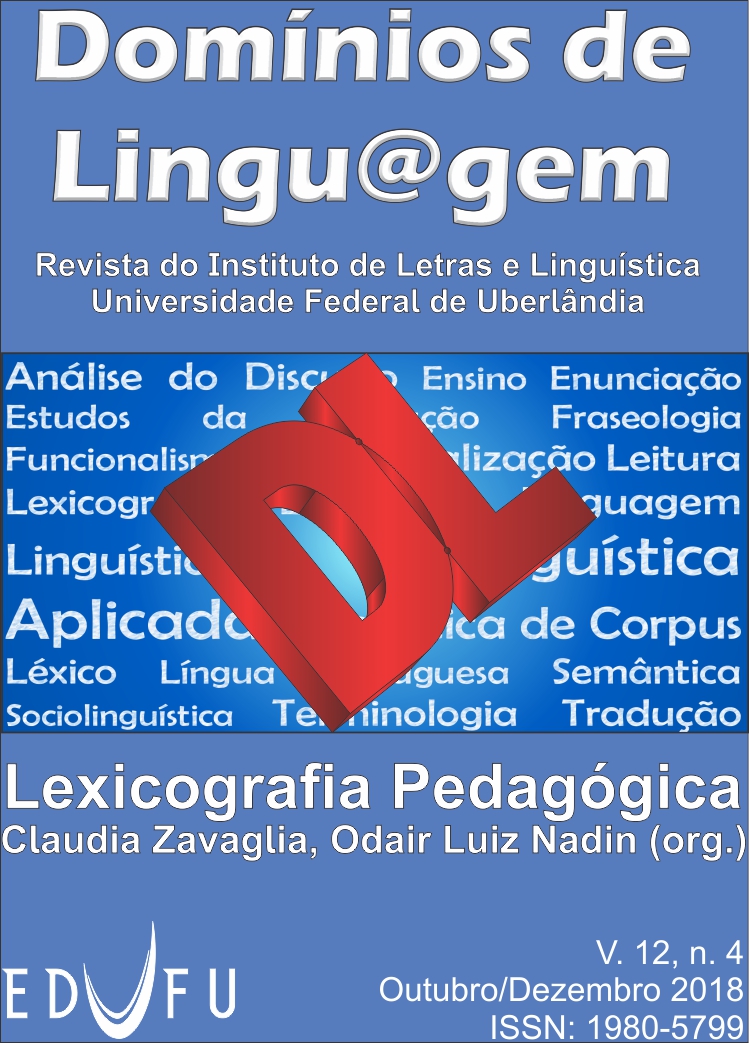Lemmatization of idiomatic expressions in dictionaries for learners
DOI:
https://doi.org/10.14393/DL36-v12n4a2018-16Keywords:
Dictionaries for learners, Spanish as a Foreign Language, Idiomatic ExpressionsAbstract
This paper discusses the insertion of phraseology, specifically of Idiomatic Expressions (IEs), in dictionaries for Spanish learners. For this purpose, the importance of their inclusion is defended, since they are non-compositional, that is, their meaning cannot be understood from the totality of the individual meanings of the elements which compose them. The analysis was done as the following: IEs were searched in two lemmatic intervals of a hundred pages each in the dictionary SEÑAS, which is a small sized dictionary directed to speakers of Spanish as a Foreign Language (S/FL) of intermediate level. Based on the results that were found, these same IEs were searched in SALAMANCA, a large sized dictionary, monolingual and directed to S/FL speakers of advanced level. With this contrastive analysis it was possible to notice some failures in both dictionaries as the lack of use marks or the no concordance in form, extension or variants of IEs.
Downloads
Metrics
References
BAPTISTA, L. M. T. R. Tratándose de expresiones idiomáticas, ¡no te rompas la cabeza ni busques cinco pies al gato! RedELE – Revista Electrónica de Didáctica/ Español Lengua Extranjera, n. 6, 2006. Disponível em: http://www.mecd.gob.es/dctm/redele/Material-RedEle/Revista/2006_06/2006_redELE_6_04Baptista.pdf?documentId=0901e72b80df9f3c. Acesso em: 13 jan. 2018.
BUGUEÑO MIRANDA, F. V. Cómo leer y qué esperar de un diccionario monolingüe (con especial atención a los diccionarios del español). Revista Língua e Literatura, Frederico Westphalen, v.8/9, p. 97-114, 2002/2003. Disponível em: http://revistas.fw.uri.br/index.php/revistalinguaeliteratura/article/view/34. Acesso em: 13 mar. 2018.
BUGUEÑO MIRANDA, F. V. Para uma taxonomia de paráfrases explanatórias. Alfa. Vol. 53, Nº 1, p. 243 – 260, 2009.
CORPAS PASTOR, G. Manual de fraseología española. Madrid: Gredos, 1997.
DANTE HERNÁNDEZ, A. B. El componente fraseológico en la enseñanza de ELE. In: Forma: Formación de Formadores. Madrid: Sociedad General Española de Librería, 2003. p. 65-92.
Diccionario Salamanca de la lengua española. Madrid: Santillana, 1996.
LARA, L. F. Teoría del diccionario monolingüe. México: El colegio de México, Centro de Estudios Lingüísticos y Literarios, 1996. 274p.
MEDINA GUERRA, A. M. Lexicografía española. Ariel Lingüística, 2003.
SEÑAS: diccionario para la enseñanza de la lengua española para brasileños. 2. ed. São Paulo: Martins Fontes; 2001.
TAGNIN, S. E. O. O jeito que a gente diz: combinações consagradas em inglês e português. Barueri: DISAL, 2013.
WELKER, H. A. Colocações e expressões idiomáticas em dicionários gerais. In: ORTIZ, M. L.; HUELVA, E. Uma (re)visão da teoria e da pesquisa fraseológicas. São Paulo: Pontes, 2001. p. 139 – 159.
XATARA, C. M. O ensino do léxico: as expressões idiomáticas. In: Trabalhos em Linguística Aplicada. Campinas: IEL-UNICAMP, janeiro-julho, 2011.
Downloads
Published
How to Cite
Issue
Section
License
Authors who publish in this journal agree to the following terms:
Authors retain the copyright and waiver the journal the right of first publication, with the work simultaneously licensed under the Creative Commons Attribution License (CC BY-NC-ND 4.0), allowing the sharing of work with authorship recognition and preventing its commercial use.
Authors are authorized to take additional contracts separately, for non-exclusive distribution of the version of the work published in this journal (publish in institutional repository or as a book chapter), with acknowledgment of authorship and initial publication in this journal.









